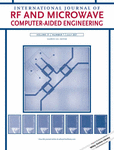Wideband, low radar cross section circularly polarized array antenna based on metasurface and sequential phase feed
Funding information: Graduate Scientific Research Foundation of Department of Basic Sciences
Abstract
A planar circularly polarized (CP) array antenna based on polarization conversion electromagnetic band-gap (PCEBG) and sequential phase (SP) feed network with wideband circular polarization and low radar cross section (RCS) is presented. The array is formed by 2 × 2 PCEBG elements. The CP performance is obtained due to the PCEBG, and the SP feed network contributes to the wide bandwidth and symmetric radiation pattern. The proposed array antenna, with an overall size of 64 mm × 64 mm × 2.008 mm (1.6 λ0 × 1.6 λ0 × 0.05 λ0 at 7.5 GHz) has been fabricated and measured. The measured results are as follows, an impedance bandwidth of 42.90% (6.61-10.22 GHz), a 3-dB axial ratio bandwidth (ARBW) of 28.3% (6.65-8.83 GHz) and a 3-dB gain bandwidth of 23.7% (6.7-8.5 GHz). The antenna exhibits left-hand CP(LHCP) characteristics with a peak broadside gain of 14.1 dB. The proposed antenna achieves an in-band and out-band RCS reduction more than 8 dB under normal incidence. The measured results are in agreement with the simulated results.
Open Research
DATA AVAILABILITY STATEMENT
All data of the antenna are measured in the microwave anechoic chamber, and the data are available.




